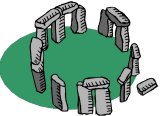
Worksheets and No Prep Teaching Resources
Reading Comprehension Worksheets
Mystery May

Mystery May
 Worksheets and No Prep Teaching Resources Reading Comprehension Worksheets Mystery May |
 Mystery May |
| edHelper's suggested reading level: | grades 5 to 7 | |
| Flesch-Kincaid grade level: | 6.09 |
|
Stonehenge
By Vickie Chao |

|
 1 On the Salisbury Plain, in southern England, there stands a cluster of huge stones. This cluster of huge stones is called Stonehenge. For centuries, people from places both far and near have come to admire it. Whoever has seen it has marveled at its beauty. Yet, they wonder what it was for. Many people have tried to figure it out. But so far, nobody has. Even today, we still know very little about it. Of the scant information we have, we can only say with any certainty that the construction occurred over three phases. From the beginning to the end, it spanned more than 1,400 years.
1 On the Salisbury Plain, in southern England, there stands a cluster of huge stones. This cluster of huge stones is called Stonehenge. For centuries, people from places both far and near have come to admire it. Whoever has seen it has marveled at its beauty. Yet, they wonder what it was for. Many people have tried to figure it out. But so far, nobody has. Even today, we still know very little about it. Of the scant information we have, we can only say with any certainty that the construction occurred over three phases. From the beginning to the end, it spanned more than 1,400 years. |
Create Weekly Reading Books
Prepare for an entire week at once! |
| Leave your feedback on Stonehenge (use this link if you found an error in the story) |
 |
Mystery May
|